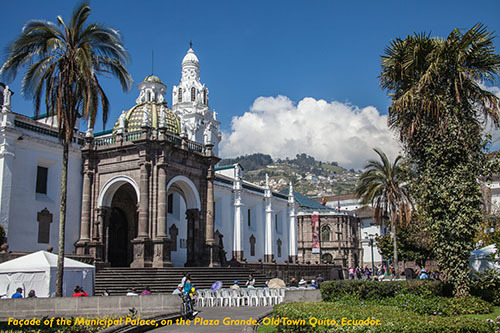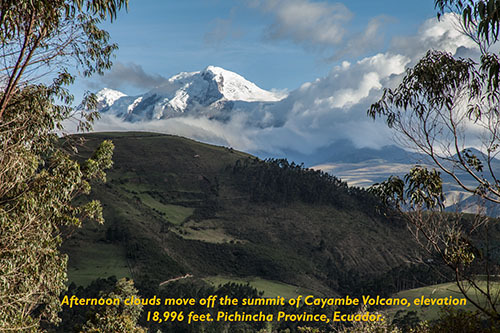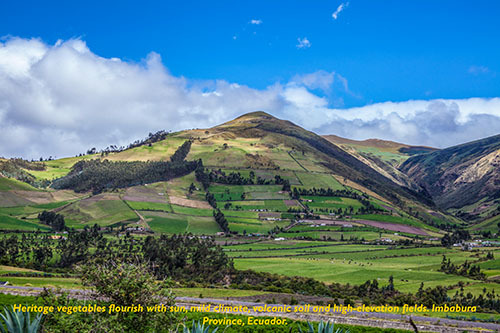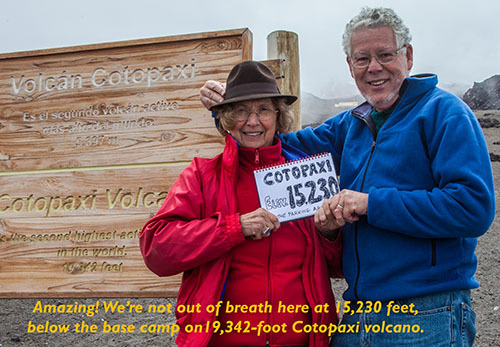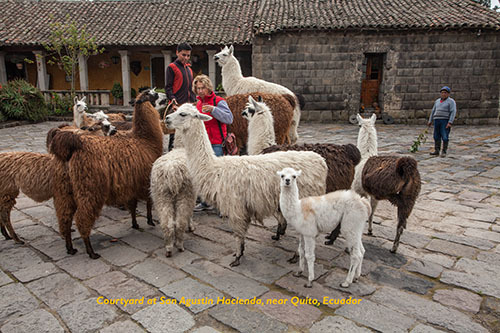I'm embarrassed to admit it: I know more about the medieval history of England and France than I know about South America. Shameful, I know. These countries are our closest neighbors, but we rarely bother to stop by and say hello. When the moment to plan a trip to central Ecuador's Andean highlands finally arrived, we knew we'd need a good guide. Not just any guide. We wanted a guru, a scholar steeped in the country's history from the pioneers to the present, and an amateur geologist, too, interested in the country's spectacular volcanoes.
Though we generally give them a wide berth, we're hopelessly fascinated by the spectacle of rumbling, roaring giants, rare elsewhere but thick on the ground in Ecuador. Of the country's 84 volcanoes, 17 over 14,000 feet, 28 are active, famously ready to steam, smoke and spew. The current performer is 16,480-foot Tungurahua, just south of Quito, which has been erupting on and off since February. (Type "Tungurahua") into your search engine and watch the fun.) As for finding history, Ecuador's historic haciendas, vast family-owned ranches, seemed a likely resource. Their owners were among the pioneers and cowboys who settled Ecuador, and became the country's first families. Many of the haciendas still survive as working ranches; others are now guest ranches offering resort activities, lodging, meals, sports and horseback riding.
Relying on a friend's recommendation, we contacted EQ Touring, a Quito and Miami-based outfitter, and asked them to offer ideas. Our finished itinerary began in Quito, the capital city, and toured the region, a jumble of foothills, volcanoes, valleys and green and gold farm fields. Endowed with a mild equatorial climate and rich volcanic soil, Ecuador's farmers are able to grow both standard and local varieties of vegetables and fruits, and at unbelievably high elevations, up to 13,500 feet in some places. Besides a car and hacienda lodging, our tour included two top-notch guides -- Cynthia Cabezas, who guided us in Quito, and Paul Aguilar, who steered us through the countryside. A highlight was the day we spent in Cotopaxi Volcano national park, with a stop at the visitors' center and another higher up for a cup of coca tea (said to ameliorate the side effects of altitude). The park's scenic highway, climbing up through steep forests and over dry, grassy meadows, ends at 15,230 feet, (see the photo below), just below the base camp where climbers overnight before beginning the ascent to the 19,347-foot summit.
Historic Quito, where your international flight will probably land, is genuinely old, founded in 1534, just 42 years after Columbus "discovered" America. Perched at 9,000 feet in the valley between the east and west ranges of the Andes, it clings to 15,669-foot Pichincha Volcano. Twenty years ago, guidebooks described the city as decrepit and grimy. But after 2000, when Ecuador adopted the U.S. dollar as its official currency, the economy revived. Now the historic center has been repaired, scrubbed and painted, the buildings restored and in a few cases, where funding remains uncertain, hidden behind convincingly-real facades.
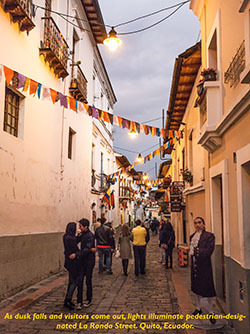
Narrow cobblestone streets, built for horse traffic, are brightly lit, trash vanishes overnight and gardens adorn the public squares. In a single stroke, crime in the historic center was nearly eliminated when the streets were converted to pedestrian-only traffic at night. Strolling after dusk, to the glow of street lanterns, we were transported back 200 years. And the city looked even better in daylight. On Independence Square (Plaza de Indepencia), where old men sat in the sunshine, visitors snapped selfies in front of the monument commemorating Ecuador's liberation. Even the city's monumental, gold-encrusted churches and monasteries echoed darker days. On the Sunday we stopped in for a peek, the priests were busy, the pews were packed and late comers stood in the side aisles beneath gloomy paintings of tortured saints.
And did the haciendas sizzle with living history, as expected? Yes, but not without some modern -- and generally appreciated -- adaptations. Both 400-year-old Le Cusin, near San Pablo Lake; and Hacienda Pinsaqui, founded in 1790 and still owned by the original family, remain the white-walled, tiled-roofed, flower-entwined structures typical of the former Spanish Empire. But Le Cusin's American owner has restored the exterior and updated the guest rooms, adding comfort while keeping the colonial influence intact. The result has earned a cadre of guests who come and stay, wintering over in spacious rooms with fireplaces, lingering over good meals, riding horses, hiking, sketching, studying Spanish and taking day trips to nearby colorful Otavalo.
Pinsaqui Hacienda, where we stopped for a bowl of locro (local cream of potato soup garnished with cheese and avocado slices), is still owned and managed by an 8th generation family member who displays a photo of himself -- or a cousin, perhaps -- in riding boots, posing inside the house with his favorite horse. Acres of lawns and spectacular views of Imbabura Volcano are part of the charm, as are Pinsaqui's 30 redecorated family-sized suites, guided horseback riding and excellent meals.
In contrast, Zuleta Hacienda, founded by Jesuits 250 years ago, kept a low profile until the 20th century when it was purchased as a retreat by the Plaza family -- which produced two Ecuadorian presidents. Both presidents in turn, the grandfather and grandson, applied their skills to ranch management, turning the 4,000-acre property into a successful diary farm and commercial cheese plant. As the family grew, the Plazas enlarged the original house, and added wings for the family and for guests, connected by a single living room and library. Today Zuleta, surrounded by sprawling green fields and forests, benefits from modern ranch management. But it's the 80-horse stable and an extensive network of riding and hiking trails that bring visitors from afar.
On the trip's last day, we stopped for lunch at the ancient and atmospheric Hacienda San Agustin de Callo. Formerly a monastery built atop an Inca temple, it's world-famous for its perfectly shaped and tightly fitted stone walls, a testament to the Inca's remarkable skills. Portions of the walls, as smooth as black velvet, remain everywhere, the dining room, the guest bedrooms, and in the courtyard. When the duty manager let the hacienda's dozen pet llamas into the courtyard for lunch guests to pet, the photos of the animals also caught the walls, visible in the rear.
To our surprise, Rumiloma, where we stayed for a night, wasn't a hacienda but a lodge. Built on a steep side of Pichincha Volcano, overlooking Quito, it's owned by ice-climbing guide Oswald Freire, who hosts his groups there before and after a planned ascent of Chimborazo, Cotopaxi or Cayambe. Curious travelers interested in learning more about this niche sport will appreciate Rumiloma's hospitality, fine cooking and authentic Irish pub, designed for post-climb celebrations. We certainly enjoyed it. In fact, for anyone doing Ecuador's volcano crawl, as we did, Rumiloma is the place to finish.
The nitty gritty: Flying to Quito requires connecting flights, and often means long airport stopovers. We kept it short by flying from Los Angeles on TACA, with a single one-hour stopover in El Salvador. Check it out before you book your flights.
We recommend EQ Touring, at www.eqtouring.com
Writer Anne Z. Cooke's next South American adventure explores Columbia's hidden world.
The images illustrating this story are provided courtesy of Steve Haggerty/ColorWorld.
